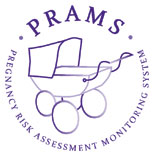About PRAMS
Frequently Asked Questions About PRAMS

PRAMS is the Pregnancy Risk Assessment Monitoring System. It is a joint research project between the state, territorial, or local health departments and the Centers for Disease Control and Prevention, Division of Reproductive Health. The Pregnancy Risk Assessment Monitoring System (PRAMS) was developed in 1987 to reduce infant morbidity and mortality by influencing maternal behaviors before, during, and immediately after pregnancy. It is the only surveillance system that provides data about pregnancy and the first few months after birth.
PRAMS is an ongoing, site-specific, population-based surveillance system designed to identify groups of women and infants at high risk for health problems, to monitor changes in health status, and to measure progress towards goals in improving the health of mothers and infants.
The purpose of PRAMS is to find out why some infants are born healthy and others are not. The survey asks new mothers questions about their pregnancy and their new infant. The questions give us important information about the mother and the infant and help us learn why some babies are born healthy and others are not.
- PRAMS provides data for state, territorial, or local health officials to use to improve the health of mothers and infants.
- PRAMS allows CDC and the states, territories, or localities to monitor changes in maternal and child health indicators (e.g., unintended pregnancy, prenatal care, breastfeeding, smoking, drinking, infant health).
- PRAMS enhances information from birth certificates and is used to plan and review maternal and infant health programs in the states, territories, or localities.
- The PRAMS sample is chosen from a list of all women who had a live birth recently, so findings can be applied to the site’s entire population of women who have recently delivered a live-born infant.
- By providing site-specific data, PRAMS allows comparisons among participating sites because the same data collection methods are used in all sites.
PRAMS provides representative data not available from other sources about pregnancy and the first few months after birth. These data can be used to identify groups of women and infants at high risk for health problems, to monitor changes in health status, and to measure progress towards goals in improving the health of mothers and infants.
PRAMS data are used by—
- Researchers to investigate emerging issues in the field of maternal and child health.
- State, territorial, and local governments to plan and review programs and policies aimed at reducing health problems among mothers and infants.
- State, territorial, and local agencies can help identify other agencies that have important contributions to make in planning maternal and infant health programs and can help develop partnerships with those agencies.
If you have recently given birth, your name may be picked by chance, like in a lottery, from the site’s birth certificate registry. If you are chosen, you will receive a survey by mail.
Yes. All answers are kept private. No one will know the name of the mother who has answered the questions.
The information collected from the mothers is used to develop health programs and policies; help doctors and nurses improve care; and make better use of health resources.
Yes! Because of the small number of mothers picked, it is important to have everyone’s answers. Every pregnancy is different. To get a better overall picture of the health of mothers and infants, we need each mother selected to answer the questions. From the information you give us, we may be able to improve health care for women and children in your state, jurisdiction, or locality.